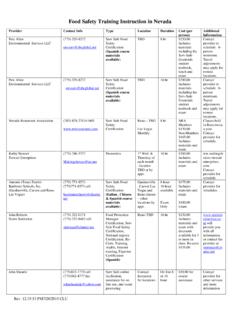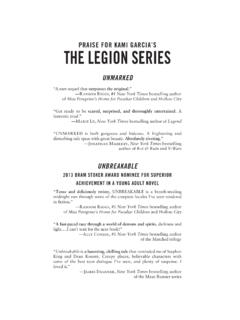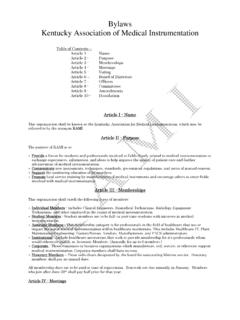Transcription of The BOy pROBLeM - kamikinard.com
1 The BOy pROBLeM (Notes and Predictions of Tabitha Reddy) Scholastic 2014 by Kami Kinard Curriculum Guide by Debra Rook and Molli Rose of Educators R&R This guide meets Common Core Anchor Standards in reading, writing, speaking, and listening; and the National Council of the Teachers of English and the International Reading Association Standards for English Language Arts. Kami Kinard, Author Kami Kinard s latest novel, The Boy pROBLeM : Notes and Predictions of Tabitha Reddy, was published by Scholastic in April 2014. Her first novel, The Boy Project: Notes and Observations of Kara McAllister, published by Scholastic in January 2012, was chosen for the 2013 Children s Choices Reading List. Kinard s poetry, fiction, and nonfiction pieces have appeared in many children s magazines, including Ladybug, Babybug, Highlights, and Jack And Jill. A co-founder of Kidlit Summer School, an online program that focuses on the craft of writing for children, Kinard is also a teaching artist on the South Carolina Arts Commission s Roster of Approved Artists.
2 She lives with her family in Beaufort, South Carolina. You can find out more about her by visiting her website Educator s R&R Curriculum Guide Creators Debra Rook and Molli Rose are master 8th grade Language Arts teachers at Chowan Middle School outside of Edenton, North Carolina. Both are National Board Certified Teachers in English Language Arts/Early Adolescence. Debra Rook will graduate from Vermont College of Fine Arts in 2015 with her MFA in Writing for Children and Young Adults. Molli Rose holds her MSE in Curriculum and Instruction and is a licensed curriculum facilitator for grades K-12. Both share a passion for connecting students to literature and sparking a love for lifelong learning. Name: _____ Date: _____ Book Trailer Foreshadowing Foreshadowing is an important literary device authors use to hint at future events in the plot. Foreshadowing builds suspense because a reader understands something BIG will happen, but the character often does not know what is coming.
3 Foreshadowing can occur through a character s speech or actions, actions of other characters, descriptions of the setting, symbols, or objects that appear frequently. Foreshadowing occurs in books, but creators use foreshadowing in video and music, too. Think about how movies, television shows, and commercials use foreshadowing to create tension or build suspense with scary music or dim lighting. Imagine this scene: a character creeps down a dark hallway testing each step as she walks. The camera cuts to a closed door at the end of the hallway, then back to the character. Her flashlight blinks off and back on and the music swells eerily. A low, steady beat gets faster and faster character s little brother jumps from behind a door! The music, sound effects, lighting, and the shots of the closed door all created suspense, foreshadowing that something unexpected is about to happen, yet both the character and the viewer experience surprise when something does happen.
4 You can see another example of foreshadowing by watching the online book trailer for The Boy pROBLeM by Kami Kinard (see the link). Watch the trailer several times, then complete the chart. What images do you see? How are these objects used in everyday life? Predict how the objects might be used in this story. How do the music, visuals, and words combine to foreshadow the plot? Music Visuals Words **Revisit your predictions after reading the book to see how well you predicted what would happen! Name: _____ Date: _____ Let s Talk About It! - Discussion Questions Group Discussion Questions for The Boy pROBLeM by Kami Kinard Section 1 (pages 1-66) 1. Identify some examples of signs that Tabitha thinks she sees. How does Tabbi s belief in signs impact the plot? 2. Kara is Tabitha s BFF. What advice does she give Tabbi? Do you agree or disagree? Why? 3. What qualities do you admire in Tabitha, Kara, and Priyanka?
5 List why you admire the qualities in each of the three main characters. 4. In one word describe the relationship between Tabitha and her mom. Justify your answer. Section 2 (pages 66-136) 1. What role does the mustache play in the plot? What could the mustache symbolize? 2. What are some natural disasters that you know about? How do natural disasters impact people in real life? How do people in real life help others who have been affected by natural disasters? Do you have any personal connections that you can share? 3. What does the title have to do with the story? 4. How does Priyanka s clothing reflect her personality? Is this true for most people you know? Explain by giving examples. Section 3 (pages 137-194) 1. What is the big betrayal in this section? What is your impression of Alex Brantley? Would you be his friend? Why? Why not? 2. Is it fair for Colleen to raise money for new uniforms by selling cupcakes?
6 Why? Why not? 4. Kara observes what Andre eats for lunch for three days. How do you feel about this method of data collection? 5. Colleen threatens to use cyber bullying when she tells Tabitha she is going to release the pizza face video. What are the possible impacts on both girls with the release of that video? Section 4 (pages 194-256) 1. Mr. Gheary saves the day by grabbing Tabitha s hand before the cupcake is thrown. Has anyone ever stopped you from making a mistake? How? Was it effective in solving the pROBLeM ? 2. How does the release of the pizza face video impact both girls? Use specific examples from the text. 3. Is Tabitha s boy project a success? Did her data collection help her find a boyfriend? Use specific examples from the text to defend your answer. 4. Brainstorm some possible themes for this novel and justify them with textual examples. Name: _____ Date: _____ I Mustache a Question Research Project Research Extension Project for The Boy pROBLeM by Kami Kinard Research Project: 1.
7 Using an aspect of the novel that grabs your interest, write a research question that will extend your knowledge of a topic addressed in the story. 2. Research your question using credible print sources, digital media, and/or interviews. 3. Develop a thesis statement incorporating new knowledge to support your research. 4. Apply what you learn to create a product (video, poster, model, or other approved media) which teaches your audience more about a topic addressed in the novel. 5. Create a tool which your audience can use to assess what they have learned. Here is an example of how you might pose a research question, search for resources, craft a thesis statement, create a product, and make an assessment: Research Topic: Hurricanes Research Question: How does a hurricane form? Credible Source List: Websites and videos from NASA, National Geographic, Ted-Ed, and the National Hurricane Center at NOAA Fact Finding Mission: What causes hurricanes to form?
8 Where do hurricanes start? Why do hurricanes only form over oceans? Why do hurricanes swirl around an eye in the middle? Thesis Statement: Hurricanes begin off the west coast of Africa where warm sea temperatures, light winds, moist air, and thunderstorms combine to create a strong, swirling storms with high winds and heavy rain. Product: Create a slide presentation describing how a hurricane starts, the stages of hurricane formation, and the forces that cause a hurricane s shape. Assessment: Create a short quiz based on the presentation. Learning Extension: Go to the National Hurricane Center s Create-a-Cane website to play the game and create a hurricane! Other possible topics to research: 1. Cyber Bullying - How does social media affect real life? 2. Divorce/Remarriage - How do families cope and thrive? 3. Natural Disasters - What are they? How do they affect different regions of the world?
9 4. Humanitarian Organizations - How can you help at a local or international level? 5. Financial Literacy - What do people need to know (and do) about money? 6. Cupcake Science - What makes cupcakes so delicious? (Hint: It s in the recipe!) 7. Prediction Power - Can people really predict the future? 8. Meaning of the Mustache - What is the history behind the famous facial hair? 9. Fun and Games - Who invented games like bingo and the cootie catcher? 10. Math Masters - Which women and men do you think make the math Hall of Fame and why? Name: _____ Date: _____ Roll On! Probability of Lucky 7 Teacher-led STEM Activity Math Curriculum Connection for The Boy pROBLeM by Kami Kinard Life is full of things which happen by chance. Is there a way to predict what is going to happen? There is no method for knowing exactly what the future holds, but the math of probability can help provide an estimate of probable outcomes.
10 This activity will examine probability through comparing mathematical predictions, also called theoretical probability, to experimental results, also called experimental probability. Overview: Students will calculate the theoretical probability for rolling a 7 with a pair of dice, roll and record results several times, then compare the experimental data collected with predicted probability. Calculators are optional, depending on the learning objective. Activity: 1. Give a Lucky 7 handout to each student and have them individually complete the top table to determine the total number of possible combinations for rolling a 7 with a pair of dice. Once this is complete, students move into groups. In groups, students compare charts to determine if they calculated the same theoretical probability. 2. Go over the formula and process for finding the theoretical probability of rolling a 7 with a pair of dice, and expressing it in several forms (calculator use optional).









